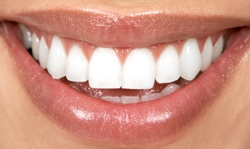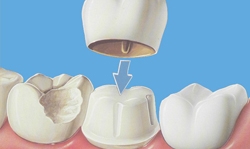Dental Crown & Bridge
 AFTER CROWN
AFTER CROWN
 BRIDGE
BRIDGE
 CROWN
CROWN
Chances are that you’re considering having a dental crown, more than one crown, or a permanent bridge designed. To assure the most esthetic and functional results possible, your cooperation and understanding are especially important to us. On this page, we’ll take you, step by step, through dental crown and bridge treatment. Why Replace Missing Teeth? Losing a tooth can be of social and psychological concern. Teeth are lost for a number of reasons including:
- Dental decay
- Periodontal (gum) disease
- Trauma (injury or accident)
When a permanent tooth is lost, the neighboring teeth are affected. Because the support and chewing forces are altered, the remaining teeth will begin to shift. The tooth above or below the one that was lost will begin to move up and out of its socket. This accelerates periodontal (gum) disease and causes a further breakdown in the dental arch. If the missing tooth is not replaced, more teeth will eventually be lost, due to the improper forces exerted during chewing.
WHAT IS DENTAL CROWN AND BRIDGE TREATMENT?
The dental crown and bridge treatment is a long-term method of replacing missing teeth.
A tooth crown is placed on an individual tooth, (somewhat like a thimble over your finger) where there is no longer sufficient tooth structure left to place a filling.
A tooth bridge spans a space where one or more teeth have been lost in the dental arch. The teeth on either end of the span are crowned and are referred to as abutments. The false teeth in a bridge that join the abutments are referred to as pontics. The dental crowns and dental bridges are most often made from superior materials such as precious metals (gold), semi-precious metals, porcelain, or a combination of metal fused to porcelain.
Both aesthetics (appearance) and functions are considered when selecting the material most suitable for you. The dental crown costs offered by restorative dentistry are affordable.
HOW IS TREATMENT PERFORMED?
At the first dental appointment, a thorough oral examination, evaluation of your dental history and necessary X-rays are completed. The diagnosis is based on these three factors. Once it has been determined that dental crown and bridge treatment is indicated, you will be set up with a series of appointments.
Note: It’s important that you keep all of these appointments.
You see, your dental crown procedure occurs in a planned sequence. Missing or postponing your appointment may cause treatment delays, allowing further tooth movement before treatment can be completed.
WHAT WILL HAPPEN?
The tooth or teeth to be treated are numbed with an anesthetic. Sometimes you can expect the side of your face to feel numb, as well. Next, during the preparation phase, your tooth or teeth to be crowned are trimmed down. This allows sufficient space for the crown or bridge to fit. After this preparation stage has been completed, an impression of that area of your mouth is taken. Your teeth will be fitted with temporary coverage until your next appointment.
At the following appointment, the crown or bridge is adjusted for proper fit, prior to permanent placement. It is often necessary to fine trim and polishes the new crown or bridge.
Other factors we consider include:
- Aesthetics – color match and appearance
- Function – chewing and biting accuracy
- Tissue compatibility- the contour of the prosthesis must allow the surrounding tissue to conform to a natural, healthy position.
Replacing Missing Teeth:
- Helps restore and maintain the natural bite.
- Prevents unnatural stress on other teeth.
- Helps keep opposing teeth in their proper place.
- Prevents shifting and tilting of adjacent teeth.
- Helps prevent further dental decay and periodontal (gum) disease.
- Maximizes your smile, speech and chewing function.

Recent Comments